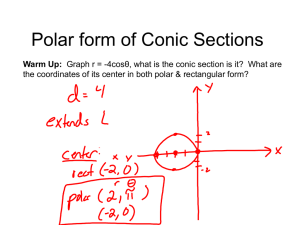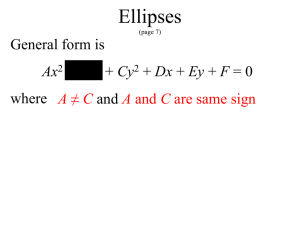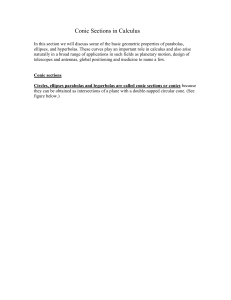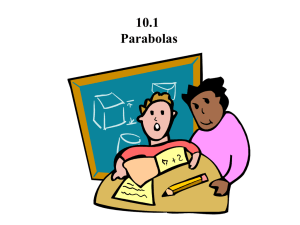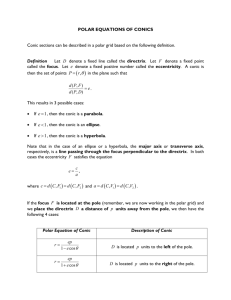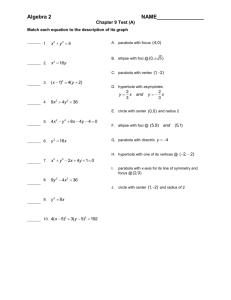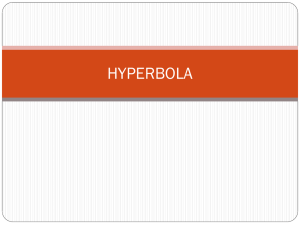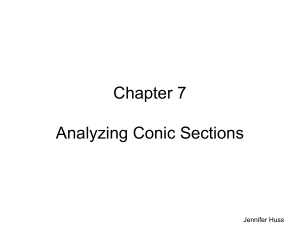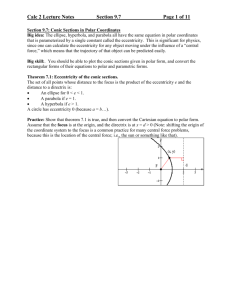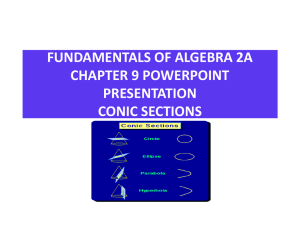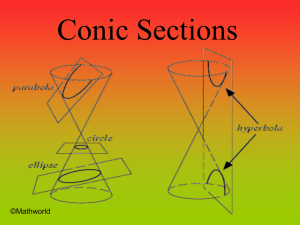Chapter 11 notes
advertisement
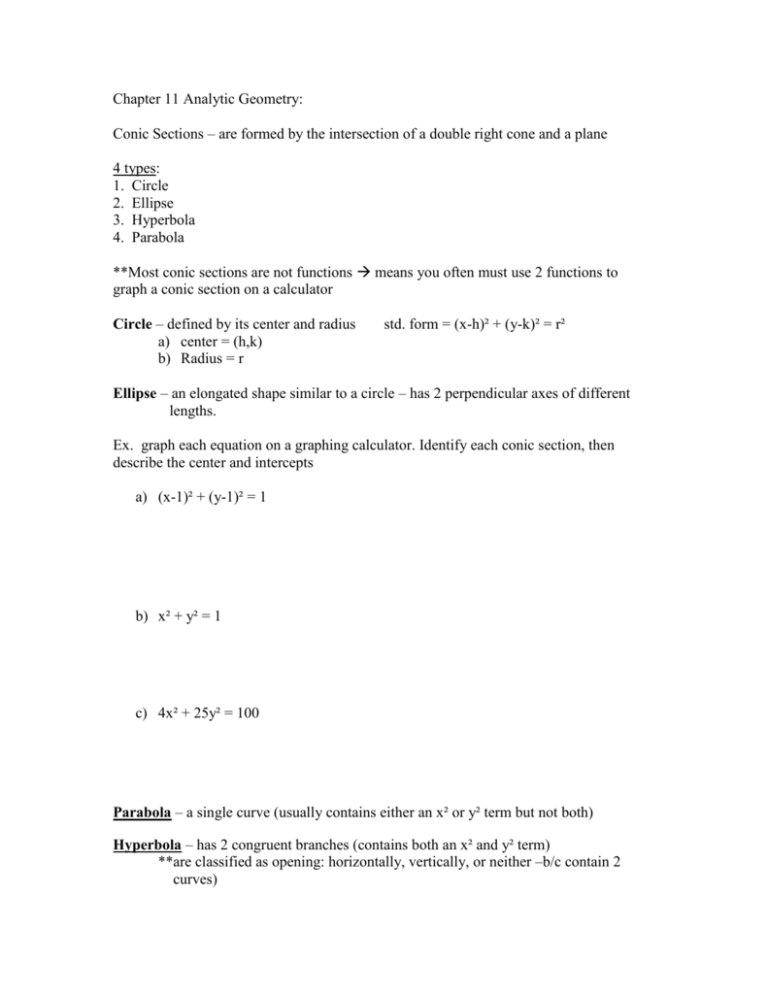
Chapter 11 Analytic Geometry: Conic Sections – are formed by the intersection of a double right cone and a plane 4 types: 1. Circle 2. Ellipse 3. Hyperbola 4. Parabola **Most conic sections are not functions means you often must use 2 functions to graph a conic section on a calculator Circle – defined by its center and radius a) center = (h,k) b) Radius = r std. form = (x-h)² + (y-k)² = r² Ellipse – an elongated shape similar to a circle – has 2 perpendicular axes of different lengths. Ex. graph each equation on a graphing calculator. Identify each conic section, then describe the center and intercepts a) (x-1)² + (y-1)² = 1 b) x² + y² = 1 c) 4x² + 25y² = 100 Parabola – a single curve (usually contains either an x² or y² term but not both) Hyperbola – has 2 congruent branches (contains both an x² and y² term) **are classified as opening: horizontally, vertically, or neither –b/c contain 2 curves) Ex. graph each equation on a graphing calculator. Identify each conic section, then describe the vertices and the direction that the graph opens. Y=-½x² y² - x² = 9 ----------------------------------------------------------------------------------------------------------Ellipse – the set of points P(x,y) on a plane such that the sum of the distances from any point P on the ellipse to the two fixed points F1 and F2 called FOCI, is the constant sum d = PF1 + PF2 **can use the distance formula to find the constant sum of an ellipse Ex. find the constant sum for an ellipse with foci F1(3,0) and F2(24,0) and the point on the ellipse (9,8) d = PF1 + PF2 d = √(x1 – x3)² + (y1 – y3)² + √(x2 – x3)² + (y2 – y3)² Ellipse has 2 axes: #1. Major Axis = the longer axis of an ellipse, and passes through both foci a) Vertices of the ellipse = the endpoints of the major axis #2. Minor Axis = the shorter axis of an ellipse a) Co-Vertices of the ellipse = endpoints of the minor axis **major and minor axis are perpendicular and intersect at the center of the ellipse THE STANDARD FORM OF AN ELLIPSE CENTERED AT (0,0) DEPENDS ON WHETHER THE MAJOR AXIS IS HORIZONTAL OR VERTICAL: Horizontal Vertical: Values a, b, and c are related by the equation: c² = a² - b² (important b/c will need to use to find the missing letter value) Length of major axis = 2a Length of minor axis = 2b a>b Standard Form for the Equation of an Ellipse Center (0,0) Major Axis Horizontal Vertical Equation x² + y² = 1 y² + x² = 1 a² b² a² b² Vertices (a,0) (-a,0) (0,a)(0,-a) Foci (c,0),(-c,0) (0,c)(0,-c) Co-Vertices (0,b)(0,-b) (b,0)(-b,0) Ex. Write an equation in standard form for each ellipse with center (0,0) with vertex (6,0) and co-vertex(0,4) a) horizontal axis is longer: (b/c a>b) step 1: form is x² + y² = 1 a² b² step 2: identify a and b a=6 b=4 = x² + y² = 1 x² + y² = 1 6² 4² 36 16 b) Co-vertex at (5,0) focus at (0,3) b=5 c=3 use a²-b² = c² a² - (5)² = 3² a = √34 c) Since co-vertex on x-axis, vertex on y so pick form: (vertical) y² + x² = 1 y² + x² = 1 y² + x² = 1 a² b² (√34)² 5² 34 25 Ex. Write an equation in standard form for each ellipse with center (0,0) a) Vertex (9,0) and co-vertex (0,5) a = 9 b =5 x² + y² = 1 x² + y² = 1 a² b² 9² 5² 11-2 Hyperbolas - if you pulled the 2 foci of an ellipse so far apart that they moved outside the ellipse Hyperbola = the set of points P(x,y) in a plane such that the difference of the distances from P to fixed points F1 and F2 (foci) are constant. (foci outside branches d = |PF1 - PF2| where d is the constant difference **use this formula to find the equation of a hyperbola Ex. find the constant difference for a hyperbola with foci F1(-8,0) and F2(8,0) and the point on the hyperbola (8,30) d = |PF1 - PF2| = |√(x1-x3)² + (y1-y3)² - √(x2-x3)² + (y2-y3)²| |√(-8-8)² + (0-30)² - √(8-8)² + (0-30)²| |√256+ 900 - √900| = 34 - 30 = 4 Hyperbola’s Contain: 1) Two symmetrical parts = branches 2) 2 axes of symmetry a) Transverse axis = contains the vertices, and if extended, the foci of the hyperbola 1) vertices of a hyperbola – the endpoints of the transverse axis 2) is not always longer than the conjugate axis b) Conjugate Axis = separates the 2 branches of the hyperbola 1) Covertices of hyperbola – endpoints of the conjugate axis Values a,b,c are related by c²= a²+b² Length of transverse axis is 2a Length of conjugate axis is 2b Horizontal Vertical Standard form for the Equation of a hyperbola Center at (0,0) Transverse Axis Horizontal(foci on x) Vertical(foci on y) Equation x² - y² = 1 a² b² y² - x² = 1 a² b² Vertices (a,0) (-a,0) (0,a) (0,-a) Foci (c,0) (-c,0) (0,c) (0,-c) Co-Vertices (0,b) (0,-b) (b,0) (-b,0) Asymptotes y= ±bx a y=±ax b Ex. Write an equation in standard form for the hyperbola with center at the origin, vertex (4,0) and focus at (10,0) Step 1: what form are in Ex. Find the vertices, co-vertices, asymptotes of each hyperbola then graph: x² - y² = 1 49 9 Step1: equation in the form x² - y² = 1 with center at (0,0) a² b² transverse is horizontal vertices: (7,0)(-7,0) co-vertices: (0,3)(0,-3) asymptotes: y= ±bx = ±3x a 7 Ex. Identify the graph of 5x²- 4y² = 20 and then graph on calculator Steps: divide both sides by 20 (b/c want hyperbola to = 1) Ex. Find the equation of the hyperbola that has vertices at (2,0) and (-2,0) and passes through the point (4,√3). Then sketch the graph using the asymptotes and label the foci. Step 1: identify where the vertices are located x-axis, so equation is horizontal (a=2) Step 2: since (4,√3) is on the graph plug 4 into x and √3 into y, 2 into a and solve for b Step 3: once know b can write the standard form 11.3 Parabolas- the graph of a quadratic function **however, it is also a conic so can be defined in terms of distance Parabola = a set of all points P(x,y) in a plane that are equal distance from both a fixed point, the focus, and a fixed line, the directrix Has an axis of symmetry perpendicular to directrix and passes through the vertex Vertex = midpoint of the segment connecting the focus and directrix Parabola bends toward the focus and away from directrix The sign of p determines the way the parabola opens Distance between the focus and directrix is 2p In past lesson – we graph parabolas with vertical axis of symmetry that open up or down *** However parabolas also have horizontal axis of symmetry and open left or Right Horizontal y=0 x= 1 y² or y²=4px 4p Vertical x=0 y= 1 x² or x²=4py 4p Direction opens right if p>0 Opens left if p<0 upward if p>0 downward if p<0 Focus (p,0) (0,p) Directrix x = -p y = -p **axis of symmetry is x-axis **axis of symmetry is y-axis Equation Graph Ex. show that the graph of the equation y²-16x = 0 is a parabola. Draw its graph then find and label its focus and directrix y² = 16x **matches form- horizontal 4p = 16 so p = 4 Focus is: (p,0) (4,0) Directrix is: x=-p P = -4 Parabola opens to the right b/c p is positive Ex. Find the focus, directrix, and equation of the parabola that passes through the point (√20,5) has vertex (0,0) and has its focus on the y-axis. Sketch the graph of the parabola and label its focus and directrix. **b/c the focus is on the y-axis, the equation has the form x²=4py **since (√20, 5) is on the graph: (√20)² = 4p(5) 20=20p 1=p **so focus is (0,1) and the directrix is the horizontal line y=-1. The equation of the parabola is x²=4y 11-4 Translations and Rotations of Conics Horizontal and Vertical Shifts: Let h and k be constant. Replacing x with x-h and y with y-k in an equation shifts the graph of the equation: |h| units to the right for positive h and to the left for negative h |k| units upward for positive k and downward for negative k (h,k) is the vertex of a parabola, and the center of an ellipse or hyperbola Ex. Identify and sketch the graph of (x+3)² + (y-6)² = 1 and find its center, major and minor axis 25 9 Ex. Identify and sketch the graph of: 9x² + 16y² + 72x + 96y + 144 = 0 Ex. Find the equation of an ellipse with center at (-6,5) such that the endpoints of its major and minor axes are (-9,5), (-3,5), (-6,7) and (-6,3). Find the coordinates of the foci. Identifying the Translated Conic: *determine how many squared terms and if there is a +/Ex. Identify and sketch the graph of y=3x² - 12x +10. Label all the characteristics of the conic. **PASS OUT CHART*** Ex. Graph the equation (x-2)² + (y+3)² = 1 9 3 All conics can be written in the general form: Ax² + Bxy + Cy² + Dx + Ey +F = 0 Which conic describes can be determined by coefficients: Classifying Conic Sections from Ax² + Bxy + Cy² + Dx + Ey +F = 0 where A,B,C ≠ 0 Conic Section Coefficients Circle B² - 4AC < 0 B=0 A=C Ellipse B² - 4AC < 0 B≠0 A≠C Hyperbola B² - 4AC > 0 Parabola B² - 4AC = 0 Ex. Identify the Conic Section that each equation represents: a) 4x² - 10xy + 5y² + 12x + 20y = 0 A=4 B=-10 C=5 (-10)²-4(4)(5) and A≠C 20>0 so hyperbola b) 9x² - 12xy +4y² + 6x -8y = 0 c) 8x² - 15xy + 6y² + x – 8y + 12 = 0 **If you are given the equation of the conic in standard form you can write in general form by expanding the binomials **If given the general form you can write in standard form by completing the square a) remember when completing the square 1) must factor out leading coefficient 2) put like terms on the same side of the = sign ex. x² + 4y² + 4x – 24y + 36 = 0 step 1: x² + 4x + ___ +4y² -24y + ___ = -36 + 4 + 4(9) = x²+ 4x + 4 + 4(y²-6y+9) = (x+2)² + 4(y-3)² = 4 Divide by 4 (x+2)² + (y-3)² = 1 4 1 Is an ellipse with center (-2,3) Major axis length = 4 Minor axis length = 2 Covertices (-2,4)(-2,2) Vertices (-4,3)(0,3) 11.5 Polar Coordinates The Polar Coordinate System: a point in plane of polar coordinate system has coordinates (r,θ) r = length of OP θ = the angle with the polar axis as its initial side and OP as its terminal side θ = can be + or – depending on whether it is measured as a clockwise or counterclockwise rotation: **Polar coordinates are not unique π/3, 7π/3, -5π/3 are coterminal angles: Ex> (2,π/3), (2, 7π/3), (2, -5π/3) all represent the same point ** r coordinate can be negative if r>0 the point (-r,θ) lies on the the line containing the terminal side of θ at a distance r, from the origin but on the opposite side of the origin from the point (r,θ) Ex. determine if the given coordinate represents the same point as (2, 4π/3) a) (2, -2π/3) b) (-2, π/3) c) (-2, 10π/3) Polar and Rectangular Coordinates Coordinate Conversion Formulas: 1) Polar Rectangular ** point P with polar coordinates (r,θ) has rectangular coordinates (x,y) where: x = rcosθ y = rsinθ 2) Rectangular polar ** point P with rectangular coordinates (x,y) has polar coordinates (r,θ) where: r² = x² + y² and tanθ = y/x Ex. convert each point from polar coordinates to rectangular coordinates a) (2,π/4) r = 2 θ= π/4 so x=2cosπ/4 y = 2sinπ/4 = 2·√2/2 = 2·√2/2 = √2 = √2 Answer: (√2,√2) b) (3,2) **From Rectangular Polar – there are not unique solutions for r and θ a) tanθ=y/x has no solutions when x=0 and infinitely many when x≠0 b) θ=tan-1y/x + kπ **not every solution works for Ptry to find solutions that represent P, you need to know which quadrant contains P 1) θ=tan-1y/x is used for Q1 and Q4 b/c represents –π/2<θ<π/2 2) θ=tan-1y/x + π is used for Q2 and Q3 b/c represents π/2<θ<3π/2 Ex. convert each point from rectangular to polar: a) (1,√3) r=√1²+√3² = 2 θ=tan-1√3/1 = π/3 so possibilities are: (2,π/3) (2,-5π/3) b) (3,-3) c) (-1,-4) r=√(-1)²+ (-4)² = √17 θ=tan-1-4/-1 = tan-1(4) = 1.33 because (-1,-4) is in Q3 θ= 1.33 + π = 4.47 (√17, 4.47) Polar Graphs equations in r=2cosθ (r,θ) = polar equation equations x and y = rectangular (Cartesian equations) Polar: (r,θ) = set of points in a plane that make the equation true **some graphs have equations that are simple in polar forms than in rectangular form: Ex. r=1 points of the form (1,θ) which is all points that are 1 unit from the pole (is unit circle) Θ = π/4 is all points from (r,π/4) that is all points that lie on the line that Makes a π/4 or 45° angle with the polar axis Ex. Graphs of other polar equations: **some polar graphs have specific forms that can be classified by special names like: cardioid, limacon, rose ** Many polar equations are functions with independent variable θ, and dependent variable r therefore, polar functions are written as r=f(θ) Ex. graph r = 1+sinθ Check: a) min and max of sin θ (-1, and 1) b) max and min of r r = 1+1 = 2 r = 1 + -1 = 0 c) consider the behavior of sin θ in each quadrant create a table: θ sinθ r = 1+sinθ 0 0 1 π/2 1 2 π 0 1 3π/2 -1 0 2π 0 1 **Use calculator in polar graphing mode **interval in window from θmin to θ should be at least as large as the period of the function **value of θ step determines the # of points plotted by the calculator a) smaller value of θ steps will result in a more accurate case but take longer to graph ** to view coordinates using Trace feature from the format menu choose Polar GC
